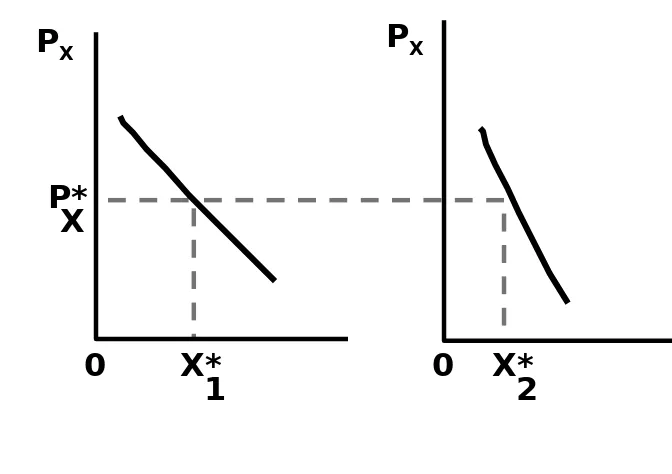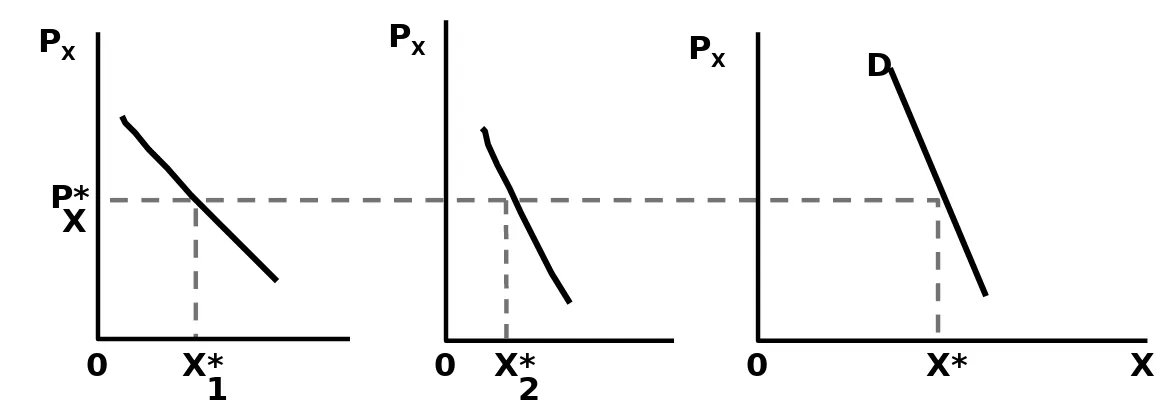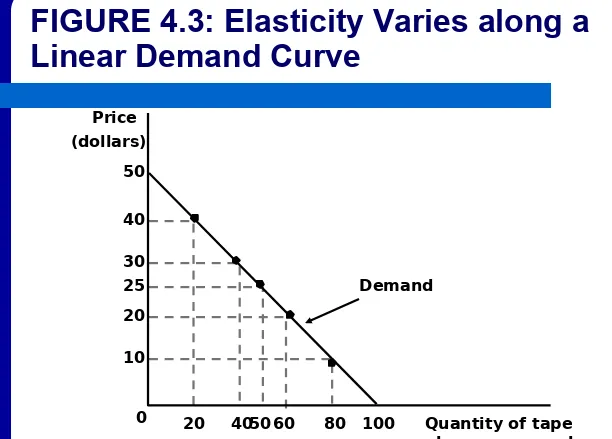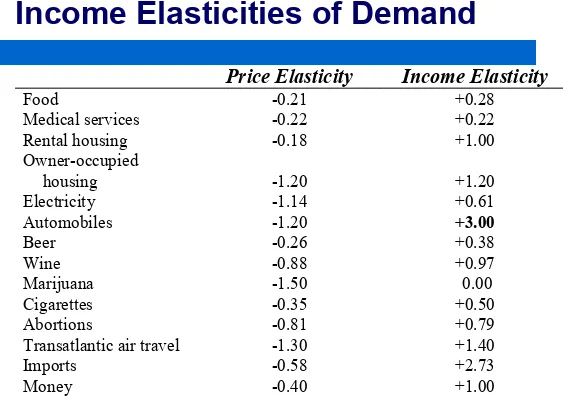Chapter 4
Market
2
Market Demand Curves
The market demand is the total quantity of a
good or service demanded by all potential
buyers.
The market demand curve is the relationship
3
Construction of the Market Demand
Curve
The market demand curve is constructed by
horizontally summing the demands of the individual consumers
Assume the market consists of only two buyers
as shown in Figure 4.1
– At any given price, such as P*X, individual 1 demands X*
4
(a) Individual 1 PX
X P*
X* 1 0
5
(a) Individual 1 PX
X P*
X* 1 0
(b) Individual 2 X*
2 0
FIGURE 4.1: Constructing a Market Demand Curve from Individual Demand Curves
6
Construction of the Market Demand
Curve
– The total quantity demanded at the market at P*X is the sum of the two amounts:
X* = X*
1 + X*2 .
The point X*, P*X is one point on the market
demand curve.
The other points on the curve are similarly
7
(a) Individual 1 PX X P* X* 1 0
(b) Individual 2 X*
2 0
(c) Market Demand X D
X* 0
FIGURE 4.1: Constructing a Market Demand Curve from Individual Demand Curves
PX P
8
Shifts in the Market Demand Curve
To discover how some event might shift a
market demand curve, we must first find out how this event causes individual demand
9
Shifts in the Market Demand Curve
For example consider the two buyer case
where both consumers regard X as a normal good.
An increase in income for each consumer
would shift their individual demand curves out so that the market demand curve, would also shift out
10
(a) Individual 1 PX X P* X* 1 0
(b) Individual 2 X*
2 0
(c) Market Demand X D
X* 0
FIGURE 4.2: Increases in Each individual’s Income Cause the Market Demand Curve to Shift Outward
PX P
11
(a) Individual 1 PX X P* X* 1 0
(b) Individual 2 X*
2 0
(c) Market Demand X D
X* 0
FIGURE 4.2: Increases in Each individual’s Income Cause the Market Demand Curve to Shift Outward
PX P
X
X** X** X**
D’
12
Shifts in the Market Demand Curve
However, some events result in ambiguous
outcomes.
– If one consumer’s demand curve shifts out while another’s shifts in, the net effect depends on the size of the relative shifts.
An increase in income for pizza lovers would
increase the market demand for pizza so
13
Shifts in the Market Demand Curve
On the other hand, if the increase in income
was for people who don’t like pizza, there
would be no significant effect on the market
demand curve for pizza.
Changes in the prices of related goods,
14
Shifts in the Market Demand Curve
If goods X and Y are substitutes, an increase in
the price of Y will increase the demand for X. Similarly, a decrease in the price of Y will
decrease the demand for X.
If goods X and Y are complements, an
increase in the price of Y will decrease the
15
A Word on Notation and Terms
When looking at only one market, Q is used for
the quantity of the good demanded, and P is used for its price.
When drawing the demand curve, all non-price
factors are assumed to not change.
Movements along the curve are changes in
16
Elasticity
Goods are often measured in different units
(steak is measured in pounds while oranges are measured in dozens).
It can be difficult to make simple comparisons
17
Elasticity
Elasticity is a measure of the percentage
change in one variable brought about by a 1 percent change in some other variable.
Since it is measured in percentages, the units
18
Price Elasticity of Demand
The price elasticity of demand is the
percentage change in the quantity demanded of a good in response to a 1 percent change in its price P in change Percentage Q in change Percentage demand of elasticity
Price eQ,P
Q P P Q P P Q Q
eQ P
19
Price Elasticity of Demand
The price elasticity records how Q changes in
percentage terms in response to a percentage change in P.
Since, on a typical demand curve, P and Q
move oppositely, eQ,P will be negative.
For example, if eQ,P = -2, a 1 percent increase
20
Values of the Price Elasticity of
Demand
When eQ,P < -1, the quantity demanded is
relatively unresponsive to changes in price
inelastic
When eQ,P = -1, a price increase causes a
proportional quantity decrease, and the curve is called unit elastic.
When eQ,P > -1, a price increase causes more
21
TABLE 4.1: Terminology for the
Ranges of
e
Q,PValue of eQ,P at a Point
on Demand Curve
Terminology for Curve at This Point
eQ,P < -1 Inelastic
eQ,P = -1 Unit elastic
22
Price Elasticity and the Shape of
the Demand Curve
We often classify market demand curves by
their elasticities
– For example, the market demand curve for
medical services is inelastic (nearly vertical) since there is little quantity response to changes in price. – Alternatively, the market demand curve for a
23
Price Elasticity and the
Substitution Effect
Goods which have many close substitutes
are subject to large substitution effects from a price change so their market demand curve is likely to be relatively elastic.
Goods with few close substitutes, on the other
24
Price Elasticity and the
Substitution Effect
There is also an income effect that will
determine how responsive quantity demanded is to changes in price.
However, since changes in the prices of
most goods have a small effect on
individuals’ real incomes, the income effect
will likely not have as large an impact on
25
Price Elasticity and Time
Some items can be quickly substituted for,
such as a brand of breakfast cereal, others, such as heating fuel, may take several years.
Thus, in some situations, it is important to
make the distinction between the short-term
26
APPLICATION 4.2: Brand Loyalty
Substitution due to price changes will likely
take a longer time if individual’s develop
spending habits.
Such brand loyalties are rational since they
reduce decision making costs.
Over the long term, however, price differences
27
APPLICATION 4.2: Brand Loyalty
It took several years, but by the 1970s the
price differences between U.S. and Japanese cars eventually convinced Americans to buy the Japanese cars.
Brand name Licensing, such as Coca-Cola
sweatshirts and Mickey Mouse watches,
28
Price Elasticity and Total
Expenditures
Total expenditures on a good are found by
multiplying the good’s price (P) times the quantity purchased (Q).
When demand is elastic, price increases will
cause total expenditures to fall.
29
Price Elasticity and Total
Expenditures
For example suppose price elasticity = -1.5.
– Suppose a family buys 100 pounds of chicken per year at a price of $2 per pound. The price elasticity of demand for chicken is -1.5. If the price of chicken increases to $2.20 (a 10% increase). What is the difference between new family’s expenditures on chicken and the old one? The family’s consumption of chicken falls to 85 pounds a year (a 15%
decrease). Total expenditure on chicken will also
30
Price Elasticity and Total
Expenditures
Of course, when demand is inelastic and prices
increase, total expenditures increase.
– A family currently uses 1000 gallons of gasoline a year when the price is $1 per gallon;
Suppose that the price elasticity of demand for gasoline is -0.5. If the price of gasoline increases to $1.10 (10% increase). What happen to expenditure on gasoline? The Consumption of gasoline falls to 950 gallons (5% decrease). Total expenditure on gasoline increase from $1000 (1000 gallons x $1/ gallon) to $1045 (950 gallons x $1.1/ gallon)
With unit elasticity, total expenditures remain
the same with a price change.
– The movement in one direction by the price is fully offset by the movement in the other
31
TABLE 4.2: Relationship between Price
Changes and Changes in Total Expenditure
If Demand Is
In Response to an Increase in Price, Expenditures will
In Response to a Decrease in Price, Expenditures will
Elastic Fall Rise
Unit elastic Not change Not change
32
APPLICATION 4.3: Volatile Farm Prices
The demand for many basic agricultural
products (wheat, corn, etc.) is relatively inelastic.
Even modest changes in supply, brought about
33
Demand Curves and Price Elasticity
The relationship between a particular demand
curve and the price elasticity it exhibits can be complicated.
For some curves, the elasticity remains
constant everywhere, but for others it is different at every point.
A more accurate way to describe it would be to
34
Linear Demand Curves and Price
Elasticity
The price elasticity of demand is always
changing along a straight line demand curve.
– Demand is elastic at prices above the midpoint price.
– Demand is unit elastic at the midpoint price.
35
Numerical Example of Elasticity on
a Straight Line Demand Curve
Assume a straight-line demand curve for
Walkman cassette tape players is Q = 100 - 2P
– where Q is the quantity of players demanded per week and P is their price.
This demand curve is illustrated in Figure 4.3
36
Price (dollars)
10 50
40
30 25 20
Quantity of tape players per week Demand
20 405060 80 100 0
37
TABLE 4.3: Price, Quantity, and Total
Expenditures on Walkmans for the Demand Function Q = 100 - 2P
Price (P) Quantity (Q) Total Expenditures (P
Q)$50 0 $0
40 20 800
30 40 1,200
25 50 1,250
20 60 1,200
10 80 800
38
Numerical Example of Elasticity on
a Straight Line Demand Curve
For prices of $50 or more, nothing is bought so
total expenditures are $0.
As prices fall between $50 and $25, the
midpoint, total expenditures increase.
At the midpoint, total expenditures reach a
maximum.
As prices fall below $25, total expenditures
39
Elasticity of a Straight Line Demand
Curve
.
, ,Q
P
b
e
Q
P
P
Q
P
P
Q
Q
e
P Q P Q
More generally, for a linear demand curve of
40
A Unitary Elastic Curve
Suppose the demand for tape players took the
form
P
Q
1
,
200
• The graph of this equation, shown in Figure 4.4,
is a hyperbola.
• P·Q = $1,200 regardless of price so demand is
41
General Formula for the Elasticity
of a Hyperbola
If the demand curve takes the following form,
the price elasticity of demand is equal to b everywhere on the curve.
0)
(b
aP
b42
Price (dollars)
20 60 50 40 30
Quantity of tape players per week
20 24 30 40 60
43
Income Elasticity of Demand
The income elasticity of demand equals the
percentage change in the quantity demanded of a good in response to a 1 percent change in income.
The formula is given by (where I represents
income):
.
I
in
change
Percentage
Q
in
change
Percentage
,I
Q44
Income Elasticity of Demand
For normal goods, eQ,I is positive because
increases in income lead to increases in purchases of the good.
For inferior goods eQ,I is negative.
If eQ,I > 1, the purchase of the good increases
45
APPLICATION 4.4: An Experiment in
Health Insurance
Most developed countries have some form of
national health insurance.
– In the U.S. Medicare covers the elderly and Medicaid is available for many of the poor.
Recently a number of comprehensive
46
The Moral Hazard Problem
A “moral hazard” problem occurs because
insurance misleadingly lowers the
out-of-pocket expenses to patients, greatly increasing their demand for medical services.
An important question, in considering
47
The Rand Experiment
The Rand Corporation conducted a
government-funded large-scale experiment in four cities.
People were assigned to different insurance
plans that varied in the generosity of coverage they offered.
48
The Rand Experiment
A rough estimate of the elasticity of demand
can be obtained by averaging the percentage changes across the various plans in Table 1
49
Table 1: Results of the Rand Health
Insurance Experiment
Coinsurance rate
Percent change in price
Average total spending
Percent change in quantity
0.95 540.00
0.50 -47% 573.00 6.10% 0.25 -50 617.00 7.7 0.00 -100 750.00 21.6
50
Low Elasticities for Hospital and
Doctors’ Visits
Using the estimate of -0.22 found in Table 4.4,
and based on other studies suggests only a small increase in hospital and doctor visits
would result from the lower prices provided by insurance.
Alternatively, researchers have found greater
51
Cross-Price Elasticity of Demand
The cross-price elasticity of demand
measures the percentage change in the
quantity demanded of a good in response to a 1 percent change in the price of another good. Letting P’ be the price of another good,
.
P'
in
change
Percentage
Q
in
change
Percentage
,P
Q52
Cross-Price Elasticity of Demand
If the goods are substitutes, an increase in
the price of one will cause buyers to
purchase more of the substitute, so the
elasticity will be positive.
If the goods are complements, an increase
in the price of one will cause buyers to buy
less of that good and also less of the good they use with it, so the elasticity will be
53
Empirical Studies of Demand:
Estimating Demand Curves
Estimating a demand curve for a product is one
of the more difficult but important problems in econometrics.
Empirical studies are useful because they a
provide a more precise estimate of the amount of change in quantity demanded that results
54
Problems Estimating Demand
Curves
The first problem is how to derive an estimate
holding all other factors (the ceteris paribus assumption) constant.
This problem is often solved, as discussed in
55
Problems Estimating Demand
Curves
The second problem deals with what is
observed in the data. The data points
represent quantity and price outcomes that are simultaneously determined by both the
demand and the supply curves.
The econometric problem is to “identify” from
56
Some Elasticity Estimates
Table 4.4 gathers a number of estimated
income and price elasticities of demand.
Some things to note
– All of the estimated price elasticities are less than zero as predicted by a negatively sloped demand curve.
57
TABLE 4.4: Representative Price and
Income Elasticities of Demand
Price Elasticity Income Elasticity
Food -0.21 +0.28
Medical services -0.22 +0.22
Rental housing -0.18 +1.00
Owner-occupied
housing -1.20 +1.20
Electricity -1.14 +0.61
Automobiles -1.20 +3.00
Beer -0.26 +0.38
Wine -0.88 +0.97
Marijuana -1.50 0.00
Cigarettes -0.35 +0.50
Abortions -0.81 +0.79
Transatlantic air travel -1.30 +1.40
Imports -0.58 +2.73
58
Some Elasticity Estimates
The income elasticities of automobiles and
transatlantic travel exceed 1 (luxuries).
The high income elasticities are balanced by
goods such as food and medical care which
are less than 1 (necessities).
There is no evidence of Giffen’s paradox in the
59
Some Cross-price Elasticity
Estimates
Table 4.5 shows a few cross-price elasticity
estimates
All of the goods appear to be substitutes and
60
TABLE 4.5: Representative Cross-Price
Elasticities of Demand
Demand for Effect of Price of Elasticity Estimate
Butter Margarine 1.53
Electricity Natural gas 0.50







